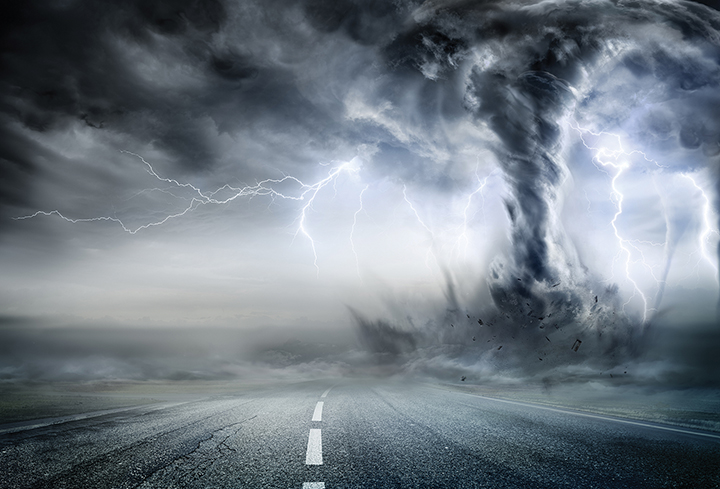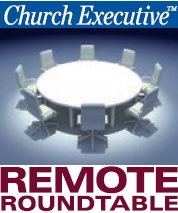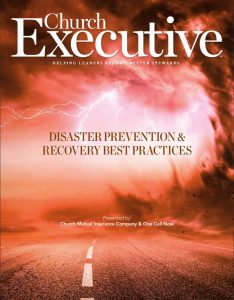
Reporting by RaeAnn Slaybaugh


Program Manager,
Faith-Based Sector
One Call Now
From an insurer’s perspective, how often do you find that churches are truly, adequately prepared in the realm of disaster prevention & recovery?
Kyle Illbeck: Churches typically focus their resources on furthering their ministry and mission, and disaster preparedness becomes an afterthought until it’s too late.
Unfortunately, it’s rare for a church to be fully prepared. This puts people and the church at risk.
Bradley Tischendorf: A void often occurs when it comes to devoting resources to preparedness efforts. Proper emergency preparedness requires time and effort. This includes comprehensive planning, training and the ability to execute emergency plans, if needed.
When the term “disaster” is used in reference to the Church, what types of events does that most commonly encompass?
Hillary Keller Bowling: Church-related disasters can include weather related events, fires,

Risk Control Analyst
Church Mutual Insurance Company
active shooters, and even cyber security events.
Illbeck: All houses of worship face many types of disasters — natural or manmade, location-specific, or universal. Some examples with the potential to threaten nearly all churches include structure fires, power failure, hazardous material releases, and violent attacks (active shooters or bomb threats).
Additionally, tornados, earthquakes, hurricanes and more might threaten a church based on its location.
Are there any types of disasters on the rise which church leaders should be particularly aware of?
Bowling: Unfortunately, we have seen violence on the rise in the church. Often, it is a domestic dispute that pours over into the church environment; or, in some cases, the church is targeted because of its belief system.
Violent incidents and resulting deaths at churches and other faith-based facilities increased dramatically in 2017.

Risk Control Analyst
Church Mutual Insurance Company
In fact, with 118 deaths recorded in 2017, it was by far the most violent year faith-based organizations have experienced in American history.
According to the Deadly Force Incident study on violence in faith-based organizations across the United States, from January 1999 through December 2017, there were at least 1,705 violent incidents with deadly force potential.
Severe weather incidents and wildfires have also been on the rise. Over the past decade, scientists have observed a significant increase in the number of large fires and the total area burned each year in the United States. Hurricanes have also been wreaking havoc on the U.S. 2017 was the deadliest hurricane season we have seen since 2005.
Tischendorf: The frequency and severity of disasters of all types change over time. Recently, however, we’ve seen an increase in natural disasters, including wildfires and hurricanes. Human-caused disasters — armed intruders and cyber-attacks — have also become more prevalent.
What best practices / strategies should a church adopt now, before disaster strikes?
Illbeck: Assess your facility, identify hazards, and work with local authorities and legal counsel to develop a plan.
Implement a plan, and train your staff and organization’s members on the plan by running drills and simulations. Update your plan or practices should any flaws be identified.
Make physical improvements to the property to mitigate the most likely hazards, and gather supplies which might be needed in a disaster situation.

Bowling: There are several things a church should do to mitigate the impact of a disaster before it ever happens. Most importantly, be prepared. Don’t be complacent and fall victim to the It won’t happen here line of thinking. Be sure to do an annual review of your insurance policies, security system and communication strategy and tools, such as One Call Now.
Once you have a security plan, communication plan, and recovery plan in place, be sure to conduct regular training sessions with your staff and volunteers. Knowing what to do when disaster strikes can save lives and money. Just as a business needs a business continuity plan, the church needs one, too.
What best practices / strategies can a church employ during a disaster?
Bowling: Communication is the first line of defense in a crisis, regardless of the type of disaster. You’ll want to begin by alerting emergency services, if appropriate. It’s imperative to then alert as many people as possible regarding the unfolding situation, including staff, volunteers and members.
As much as possible, provide instructions, including any evacuation plans. Keeping people away from the area until it is safe can save lives.
Crisis communication starts with having accurate contact information for everyone, and having it in a place you can access it, even when the power is out. One Call Now can help you manage contacts and get the word out to your congregation when you need it most.
Tischendorf: Have a plan to communicate, both internally to congregants and staff, and externally with emergency services.
Have key employees or volunteers assist during the event.
Designate safe areas in the building, or rally points away from the building, if evacuation is required.
What about after a disaster? Any best practices to share?
Illbeck: Provide first aid to the injured, and account for those who were present at the location.
Have a plan to communicate with internal and external stakeholders about the disaster’s impact on the church and steps for recovery. Remember to consider staff, members, emergency services, utilities, news media and families. Also remember to communicate with your insurance carrier.
Conduct a physical assessment of the facility to assess any damage which might have occurred, and identify any secondary threats.
Use clear, concise messaging — not code words — to avoid confusion and to provide clear directions to all involved, even guests.
Empower staff and volunteers to communicate; don’t rely solely on one person.
Have alternative forms of communication in the event that one fails.
Bowling: Make any necessary insurance claims as soon as possible to avoid any delays in processing.
Communicate regularly with your congregation. Ask for volunteers in clean-up, prayers and donations if needed. Let everyone know when and where services will be restored. No one likes being in the dark; and in a time of tragedy, many rely on their church. If the church is silent, they can be lost and feel helpless. Regular communication will keep the community strong, even if they cannot be in their place of worship together.
What communication tools are at a church’s disposal, and when should they be acquired?
Bowling: Mass notification tools like One Call Now should be in place for regular communication.
Having a system in use regularly will ensure users are trained on using the system, are comfortable with the system, and can even save messages in the system to send in case of emergency.
Tischendorf: A combination of communication tools is best, including in-person announcements during services or meetings, posts in bulletins, over PA systems, on social media platforms.
Phone trees, mobile apps, two-way radios and relationships with local media outlets can also enable quick, effective communication.
It’s never too early to begin filling a communications toolbox. A plan to obtain and activate these tools can help a church avoid a communications breakdown and confusion in the event of a disaster.
Who should be trained to use them, both staff and volunteer?
Illbeck: Although official communications from the church should be limited to those with authority, enabling and training a wide array of individuals to execute your communications plan is recommended. At the very least, pastors, ushers, safety personnel and leaders of ministries (such as Sunday school) should all be trained and prepared to communicate in an emergency.
Bowling: Both staff and volunteers. Each group can have their own messenger code. They can set up subgroups to only contact certain teams, or they can contact everyone, whichever works best for the group.
As the staff / volunteer force grows and shifts, how should this training be adjusted?
Bowling: Ongoing use ensures you’re ready to use the system when the unthinkable happens. If you have a messaging system but don’t use it regularly, monthly trainings are advised.
Tischendorf: Training should be a recurring event for all key stakeholders. As personnel changes occur, disaster plans and training should be reviewed to ensure there are no newly created gaps in the plan.
What form might that training take?
Illbeck: Training should encompass all hazards faced and should start with a thorough understanding of the plan. It should include a discussion of all aspects of the plan to ensure comprehension. Table-top exercises and drills can then be used as supplemental training to flush out any flaws and to prepare all stakeholders for a real-life event.
Training should occur at least annually, or more frequently, based on the hazards faced.
Bowling: You can send test messages or use it for regular communication, such as children’s ministry reminders, prayer chains, funeral announcements, etc.
What is the typical learning curve for communication tools like these?
Bowling: Most people can learn a system like One Call Now in less than an hour. You can purchase, load your contact information and be using it all in the same day.
Remember: keeping the contact list up to date is the most important part of any communication plan.
Tischendorf: Ease of use is critical in a disaster situation, since focus, critical thinking and decision-making can all be hindered in a disaster.
All stakeholders in the church-at-large need to know where to find or receive information if needed. The key points of the communications plan should be understood by all, and key leaders should be identified.


